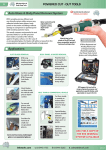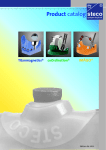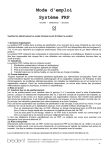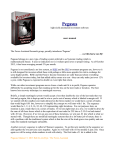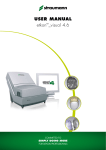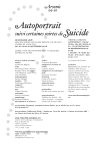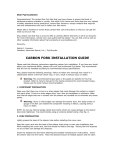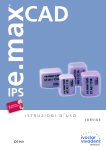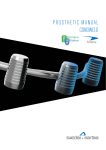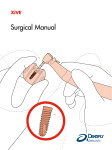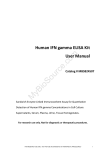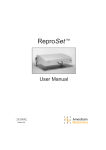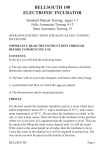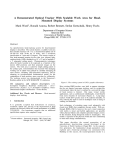Download Find a small instruction for use here! - steco
Transcript
® Instruction for use Titanmagnetics® A0 / B0 A1 A2 A3 A4 B2 B3 B4 B5 steco system-technik K.00.01.EN5/12.08 CAVE! Functional height Implant surface X B1 A. Instructions for incorporating Titanmagnetics® into an existing denture (chairside) A0/B0. Selection of the abutment height Titanmagnetics® are offered with integrated spacers in different abutment heights. For the correct selection the gingiva thickness must be measured before insertion. Subgingival inserted Titanmagnetics® project at least 1 mm from the gingiva. A1. Application After removal of the cover screw, the Titanmagnetics® insert is screwed into position with its convex (conical) functional area inserted into the torque wrench insert. The external octagon of the insert and the internal octagon of the torque wrench insert must fit perfectly together. A magnet in the torque wrench insert ensures a looked connection. The insert can now be carefully screwed into the implant. The last revolution is completed with a torque wrench (maximum tightening torque 20 Ncm). The insert must be retightened with the torque wrench insert 10 to 14 days later to prevent the insert from loosening (danger of breakage). Do not screw in by hand or with forceps. Healing cap The Titanmagnetics® insert can be used as a healing cap. A collar of scar tissue forms around the final prosthodontics abutment and will remain in place (Prof. Donath). The gingiva should be left to heal for 10 to 14 days between application of the inserts and taking the impression. A2. Fitting The existing denture is carefully ground from the basal direction at the positions above the magnets. A hollow must be created to allow the Titanmagnetics®insert and the denture magnet to fit correctly under the denture. A3. Use of positioning cuff The positioning cuff protects the margin of the gingiva and the functional surfaces during polymerisation of the Titanmagnetics® denture magnets, and also ensures a resilience of 0.3 mm. If the magnet head projects more than 2 mm above the gingiva (for example with transgingival implants), use positioning cuff no. 1. Use positioning cuff no. 2 for subgingival implant inserts (1-2 mm above the gingiva). The positioning cuff is fixed over the head of the Titanmagnetics® insert in the mouth. The denture magnet is then set into the flat cavity. The reverse funnel shaped positioning cuff No. 1 forms a matching opening in the denture base. This guarantees tension-free seating. The positioning cuff is made of silicone and can easily be removed after the polymerisation of the denture magnet. A resilience ring is also used as a spacer (0.3 mm) between the inserts and the denture magnet for the K-Line. CAVE: ! B6 A4. Finishing The denture magnets are polymerised into the previously created cavities with cold-curing polymer. The plastic is inserted basally, then the denture is placed in the mouth. The patient must bite hard until the polymer has hardened (min. 15 min) if the denture is removed before complete polymerisation, the denture magnets may not be in their correct position, resulting in occlusion problems and premature wear of the Titanmagnetics®. Excess polymer can be carfully removed. Do not damage the titanium housing. B. Instructions for incorporating Titanmagnetics® into a new denture (labside) B0. See A0. B1. See A1 B2. Impression The Titanmagnetics® impression post is placed on the insert. A magnet in the impression post locks it to the insert. Check that the fit is correct with a finger. The impression is made with a closed individual impression tray which must be blocked out about 1 cm above the implant position. Direct application of the impression compound to the impression post has proven to be advantageous. When using the K-Line, the Titanmagnetics® denture magnet (U.00.01.K500) is used as the impression post. B3. Model fabrication The Titanmagnetics® laboratory replica is inserted into the impression post. The integrated magnets cause a strong connection. The model should be made of a stable super dental plaster and dental plastic (around the implant positions). B4. Bite impression and setup The Titanmagnetics® denture magnet is placed into the bite impression and into the following setup. This improves safety during the following processes. The laboratory should use its own denture magnets for this procedure. B5. Model cast basis / plaster precast A model cast base and reinforcement must be used to avoid the risk of breakage. The master cast is duplicated with the denture magnets in place. The top of the magnetic head of the insert projecting from the gingiva must be blocked out in a funnel-shape. Optimum functional and aesthetic results are achieved using a prefabricated plaster precast. B6. Finishing The positioning cuff protects the functional surfaces during the cementing of the denture magnets and creation of a resilience of 0.3 mm. It is pulled over the head of the Titanmagnetics® insert on the model and can be removed without difficulty when the denture magnet has set. The denture magnets are cemented or polymerised into the cavities with composite cement or with autopolymerising resin. The 0.2 mm thick titanium housings must never be ground. Grinding could release the intra-orally unstable magnetic alloy (Sm2Co17). The resulting corrosion would reduce the magnetic field strength and lead to further destruction of the titanium housing. Titanmagnetics® must not be soldered or laser-welded. The heat created by soldering would irreversibly destroy the magnetic field strength and laser-welding pe rf or at e the titanium housing. steco-system-technik GmbH & Co. KG • Kollaustr. 6 • 22529 Hamburg • Germany Tel.: +49-(0)40-557781-0 • Fax: +49-(0)40-557781-99 • e-Mail: [email protected] • Internet: www.steco.de R ® Product data sheet Titanmagnetics® CAVE: steco system-technik K.00.22.EN5/12.08 Caution is required when using magnets. Keep magnets away from magnetic data storage media and electronic devices is especially recommended. Titanmagnetics® do not affect cardiac pacemakers when they are used as directed (no direct contact). Magnetic abutments and denture magnets must be removed before performing MRI diagnoses (Magnetic Resonance Imaging). Otherwise the magnets can be damaged. This information must be given to the patient. Loosened Titanmagnetics® inserts can damage the inner implant thread. Patients should therefore immediately see a dentist in order to have the Titanmagnetics® inserts retightened. The denture should be funnel-shaped at its base around the top of the magnet. The titanium sleeves, only 0.2 mm thick, must not be ground. Titanmagnetics® must not be soldered nor laser-welded. The heat created by welding will irreversibly destroy the magnetic field strength and laser could perforate the titanium housing. If the titanium sleeve is damaged (perforation), the damaged parts must be replaced immediately, otherwise the intra-orally unstable magnetic alloy (Sm2Co17) could be released. This would lead to corrosion and loss of the magnet field strength and further destruction of the titanium sleeve. For risk management damaged parts should be sent to the manufacturer or to the distributor with their product- and batch numbers, the insertion date and the implant site. Please record the product- and batch numbers of the Titanmagnetics® inserts and denture magnets in the patient's file or in the warranty booklet. 1. Description of the Titanmagnetics® system parts [with the product classification of the Steco® product number system] The different Steco® products are classified by the initial letter of the product number: A = Impression items I = Inserts P = Positioning cuffs D = Diagnostic systems and -tools M = Laboratory replica U = Universal Titanmagnetics® H = Auxiliary tools O = OEM items V = Connection elements Four Titanmagnetics® product lines with different design, head diameter and withdrawal force are available for dental and craniofacial use. X-Line: spherical, ø 4.8 mm, 1.6 N withdrawal force/ Z-Line: spherical, ø 5.8 mm, 3.0 N withdrawal force K-Line: conical, ø 5.2 mm, 1.6 N withdrawal force / T-Line: telescope, ø 5.8 mm, 1.4 N withdrawal force (facial prosthetics). Titanmagnetics® are part of a general design and must be used with original Steco® parts and instruments only, according to the instructions and recommendations of the steco-system-technik. Otherwise, no liability can be accepted. The individual parts are designed to work with the different implant systems. For root post caps only spherical Titanmagnetics® of the X- and Z-Line are available. 2. Magnetic fields There are no references in the current literature indicating that permanent magnetic fields with flux density in the range to about 300 mT (millitesla) can be locally harmful for humans. Titanmagnetics® create, like the earth itself, a permanent magnetic field which cannot be compared to an electromagnetic field (such as that of a mobile telephone or a high-voltage transmission line). The average magnetic field strength amounts to about 186 mT (X-, K- and T-Line) or 300 mT (Z-Line). 3. Materials Titanmagnetics® insert and root post caps Titanmagnetics® denture magnet Housing: pure titanium according to DIN 17850 (Ti4) / ASTM F 67 (Grade 4) Titanmagnetics® torque wrench insert Magnetic core: Sm2Co17, laser-welded gas-tight in titanium Titanmagnetics® impression post Titanmagnetics® laboratory replica Titanmagnetics® positioning cuff Dental silicone Instruction for disinfection and sterilisation Sterilization can be done in the autoclave with moist, hot air (e.g. gravitation principle or fractionated pre-vakuum at 132/134°C at 3 bar, 5 minutes). Please refer also to the manufacturer's user manual and use validated processes only. Instruction for cleaning Increased plaque deposits on the highly polished Titanmagnetics® could not be detected (Tiller 1993, 1995). However, if plaque deposits are detected on Titanmagnetics®, they must be removed immediately. Never scratch the surface of the Titanmagnetics® with metal instruments. Deposits on the functional surfaces will increased the distance between the components, leading to an apparent loss of adhesion. Advices for use Titanmagnetics® inserts and denture magnets are for single use in one patient.Reuse is not allowed, because reprocessing treatment may lead to mechanical breakdown of the thread or to damages of the surface. Patients should return to the practice at three months recall intervals for a check of the magnets for wear of the titanium sleeves and to check the inserts are not loose. Correct seating of the denture should also be checked. Relining may also be required. 4. Indication 1. Gero-prosthodontics: anchoring of hybrid and partial dentures in class III (toothless jaw) and class II (very few teeth left) (classification according to the consensus paper 12/2008). For the treatment of class III-cases with removable dentures in the upper jaw 6 implants and in lower jaw 4 implants are recommend. In individual cases a treatment with a deviating number of implants, as aforesaid, may be indicated. These cases depend on the anatomical and prosthetic conditions of the patient. Because of the minimal loading forces on the implants, magnetically anchored dentures can be planned on short (6 mm) implants (applicable for X- and Z-Line only). 2. Facial prosthetics: anchoring of facial prostheses and resection prostheses. 5. Dimensions 1) Height/Length 2) Diameter X-Line T-Line K-Line Z-Line Product [product number system] 1) Titanmagnetics® insert [I] for implants Titanmagnetics® denture magnet [U] Titanmagnetics® positioning cuff [P] Titanmagnetics® resilience ring [P] Titanmagnetics® torque wrench inserts [H] Titanmagnetics® impression post [A] Titanmagnetics® laboratory replica [M] Titanmagnetics® root post caps [V] 1) System dependent 2.65 mm 1) 0.30 mm ----------diverse 1) 6.95 mm 1) 9.00 mm 1) 2.50 mm 1) 2) 4.80 mm 2) 4.80 mm 2) 15.00 mm ----------2) 4.80 mm 2) 4.80 mm 2) 4.80 mm 2) 4.80 mm 1) System dependent 3.15 mm 1) 0.50 mm ----------diverse 1) 6.95 mm 1) 10.00 mm 1) 3.00 mm 1) 2) 5.80 mm 2) 5.80 mm 2) 15.00 mm ----------2) 5.80 mm 2) 5.80 mm 2) 5.80 mm 2) 5.80 mm System dependent 1) 2) 5.20 mm 1) 5.00 mm 2) 5.20 mm ----------- 2) 15.00 mm 1) 0.30 mm 2) 6.00 mm diverse 2) 5.20 mm 1) 1) System dependent 5.70 mm 1) 0.30 mm ----------diverse 1) Use the denture magnet! 7.50 mm 7.50 mm 2) 5.20 mm 1) 10.50 mm No root post cap available! 2) 5.80 mm 5.80 mm 2) 15.00 mm ----------2) 5.80 mm 2) 5.80 mm 2) 5.80 mm 2) No root post cap available! 6. Advantages of magnetic anchorage + Easy and stress-free delivery and removal of denture (Gbara 1995), cost-effective (Göhring 1997) + Good implant and gingiva-supported seating of dentures (Wirz 1994) + Avoidance of unphysiological loading forces on the implant (Jäger and Wirz 1993, 1994, Vesper 1995) + Easy oral hygiene for implants and dentures (Tiller 1993, 1995) + Reduced time and expense for dentist and dental technician (Stemmann 1995, 1997) 7. Literature The manufacturer can provide an extensive literature list or see www.steco.de. steco-system-technik GmbH & Co. KG • Kollaustr. 6 • 22529 Hamburg • Germany Tel.: +49-(0)40-557781-0 • Fax: +49-(0)40-557781 99 • e-Mail: [email protected] • Internet: www.steco.de R


